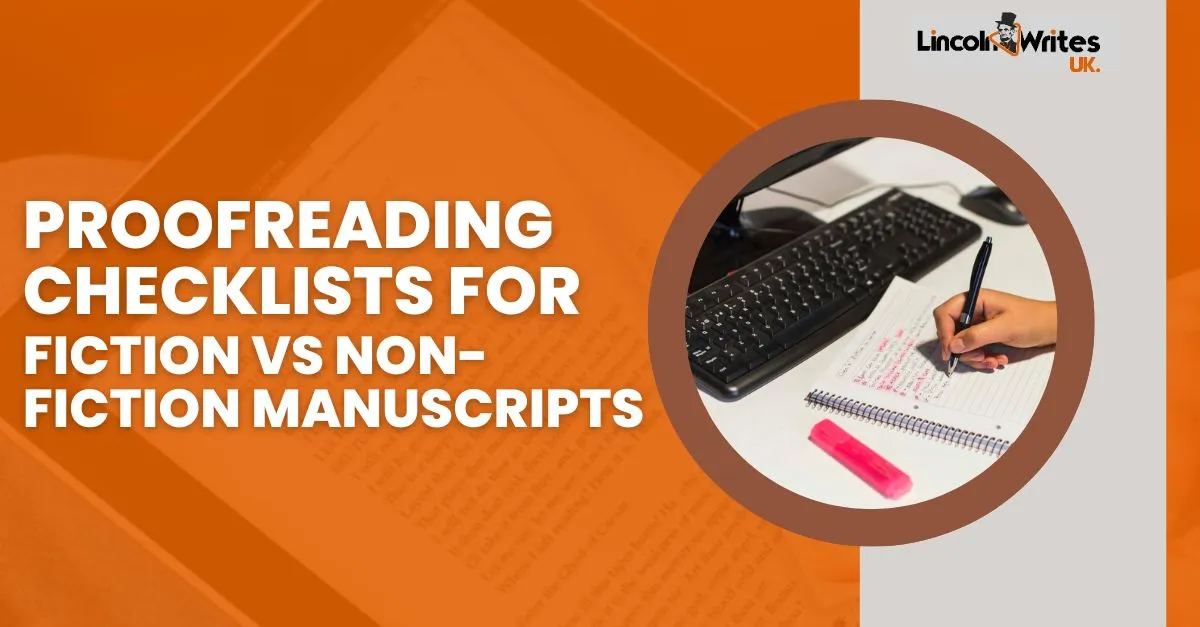You’ve finally made it to the last draft. The characters are breathing. The chapters flow. The arguments are solid. Whether you’ve written a heartfelt memoir under memoir ghostwriting or a data-driven business guide, you know what’s next: proofreading.
But proofreading isn’t just about correcting spelling and grammar. It’s about catching inconsistencies, factual errors, formatting glitches, and sneaky little typos that hide in plain sight. And depending on your genre, your proofreading process should look very different.
That’s why we’ve created two tailored proofreading checklists, one for fiction and one for non-fiction, so you can polish your manuscript with confidence.
Let’s break it down.
Why Genre-Specific Proofreading Matters
Before we get into the checklists, let’s be clear: proofreading is not editing. It’s the final check before your book goes to print, gets uploaded, or hits the inbox of your chosen ebook publishers in the UK.
Fiction and non-fiction serve very different reader expectations. One aims to immerse, the other to inform. One bends rules for voice, the other must stay rooted in fact. So, naturally, your proofreading process should reflect those needs.
It’s also worth remembering that your proofreading approach can directly impact the results of your ghostwriter ROI, especially if you’re working on high-stakes projects like business leader ghostwriting or launching a book tied to a wider campaign with ebook publisher marketing support.
Fiction Proofreading Checklists
Fiction is all about flow, emotion, and consistency. Here’s what to look for when proofreading a novel, short story, or literary manuscript:
1. Spelling and Grammar
- UK vs US English consistency
- Subject-verb agreement
- Misused words or homophones
- Dialogue punctuation and formatting
- Run-on sentences and fragments
Modern proofreading tools 2025, like Grammarly or ProWritingAid, can catch the basics, but always do a manual check too.
2. Character Consistency
- Names are spelt the same way throughout
- Characters’ ages, backgrounds, and arcs are consistent
- Dialogue matches voice and personality
- Reactions and motivations feel believable
If you’re working with a ghostwriter on tight deadlines, this is a key area where mistakes tend to slip through.
3. Timeline and Setting
- The sequence of events makes sense
- Time references are consistent (e.g., no Friday happening before Thursday)
- Seasonal details match locations
- No sudden teleportation of characters!
4. Dialogue Formatting
- Proper use of quotation marks
- Clear attribution of who’s speaking
- Avoidance of long, confusing monologues
- Tags and beats are formatted correctly
5. Word Choice and Tone
- Avoid repetition and filler words
- Watch for overuse of adverbs or exclamations
- Check tone consistency (especially across emotional scenes)
Use proofreading symbols if working in print or collaborating with editors.
Non-fiction Proofreading Checklist
Whether you’re writing a self-help guide, a white paper, or content created under ghostwriting legal aspects, factual accuracy and clarity are king.
1. Grammar, Spelling, and Punctuation
- Sentence clarity and conciseness
- No dangling modifiers or passive voice overuse
- Correct apostrophe usage (a surprisingly common issue!)
- Punctuation uniformity (Oxford comma, anyone?)
2. Factual Accuracy
- Verify statistics and data
- Check spellings of names, places, and organisations
- Confirm quotes from external sources
- Verify hyperlinks (for digital formats)
It is especially vital if you’re writing for experts or audiences who will notice inconsistencies, common in business leader ghostwriting.
3. Citations and References
- Correct formatting (APA, MLA, Chicago, etc.)
- Every cited idea is referenced
- In-text references match the bibliography
- URLs are current and functioning
Tools like Zotero or EndNote can help streamline citation checks.
4. Structure and Headings
- Headings and subheadings follow a logical hierarchy
- Bullets and numbered lists are formatted consistently
- Table of contents matches actual content
- Section transitions are clear and smooth
Especially important for those planning to choose ebook publisher routes with metadata requirements.
5. Visuals and Captions
- Images are high-resolution and properly placed
- Tables and charts are labelled clearly
- Captions are grammatically correct
- Alt-text is included for accessibility (especially for ebooks)
Proofreading in Self-Publishing vs Traditional Publishing
With traditional vs ebook publishing, the role of proofreading shifts slightly. Traditional publishers typically handle it in-house, though that doesn’t mean you shouldn’t proofread before submitting. First impressions still matter.
In proofreading for self-publishing, however, the entire responsibility falls on you. Your reputation is at stake, especially if you’re aiming to distribute across ebook distribution channels in the UK or submit to ebook publishers in the UK with strict formatting requirements.
That’s why authors who self-publish, or who publish under personal brands, are increasingly investing in professional book proofreading services.
When to Hire a Proofreader
Not sure when to hire a proofreader? Here’s your cheat sheet:
- After all major edits and revisions
- Before submitting to agents or publishers
- Before uploading to Amazon, Kobo, or any other platform
- After a round of beta reader feedback
- When you feel “too close” to the manuscript
This final check ensures your manuscript meets both reader expectations and industry standards, including emerging ones seen in ebook publishing trends 2026 UK.
Choosing the Right Support
Proofreading tools help, but human touch matters, especially when tone, emotion, and credibility are on the line.
If you’re publishing something technical, personal, or time-sensitive, it’s worth working with professionals who understand your genre and goals, whether it’s a career-defining book, a passion project, or a ghostwritten title. Accuracy matters.
At Lincoln Writes UK, we offer book proofreading services tailored to both fiction and non-fiction. We’ve worked on everything from fast-turnaround projects to deeply researched biographies and business memoirs, including projects tied to ghostwriter ROI.
Final Note
Using a tailored proofreading checklist ensures you’re not just crossing t’s and dotting i’s. You’re protecting your work, your credibility, and your future success as an author.
Fiction needs flow and immersion. Non-fiction needs accuracy and structure. Both need precision.
So whether you’re working with a ghostwriter or going it alone, remember: the right checklist (and the right team) can take your book from “pretty good” to “publish-worthy.”
Ready to give your manuscript the final polish? Let’s talk. We’ll help you navigate the final mile with care, expertise, and professionalism.


